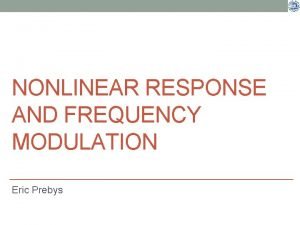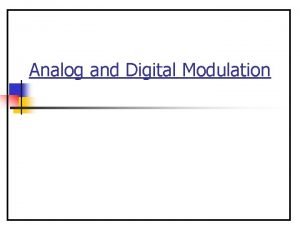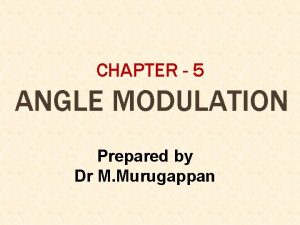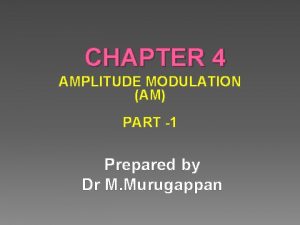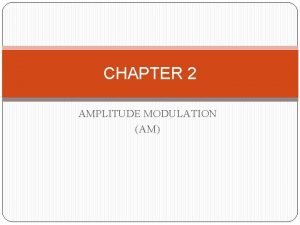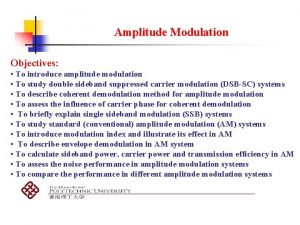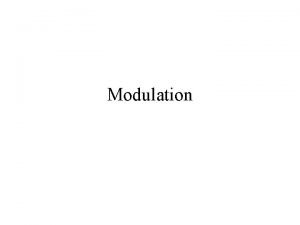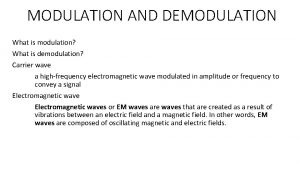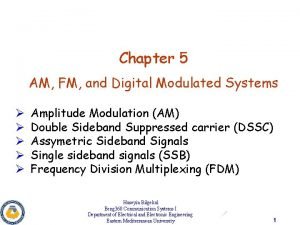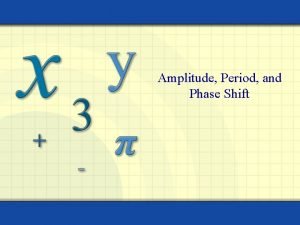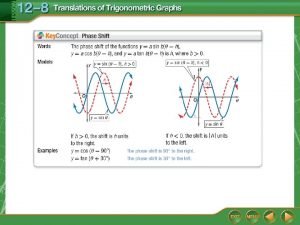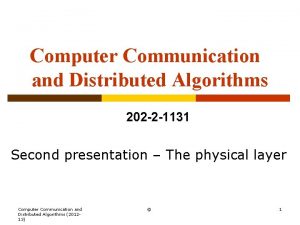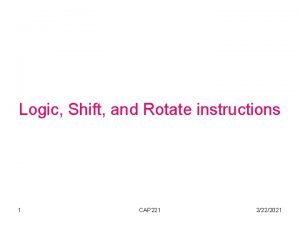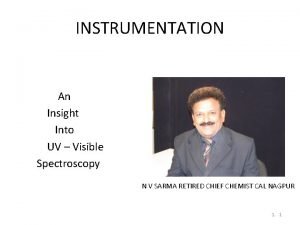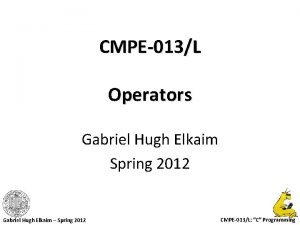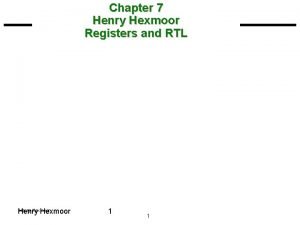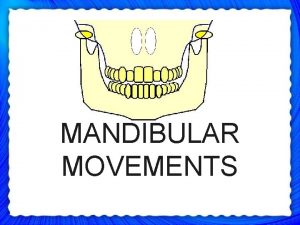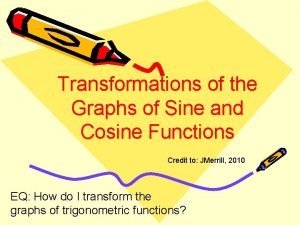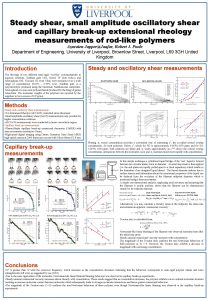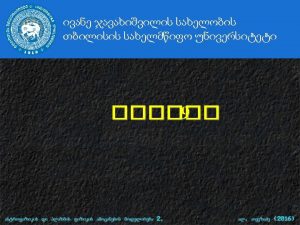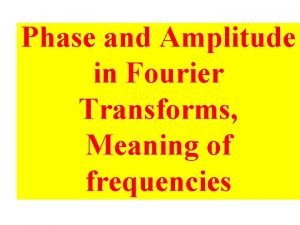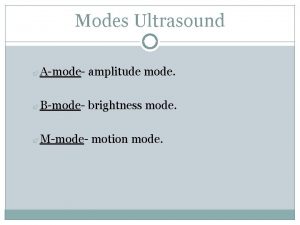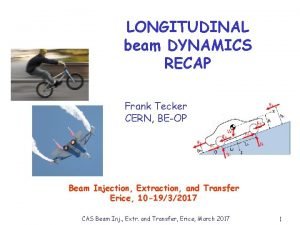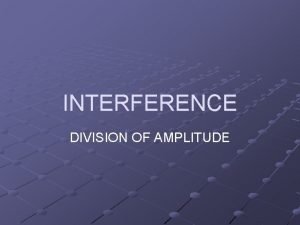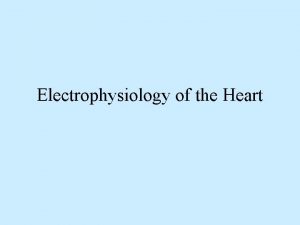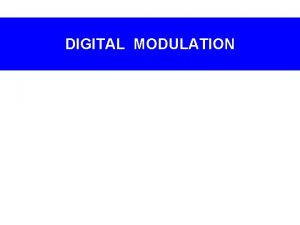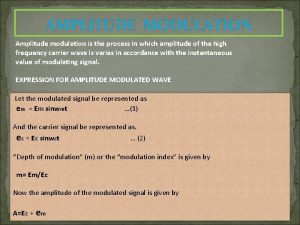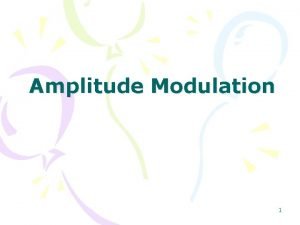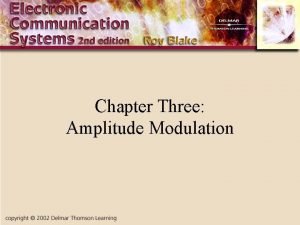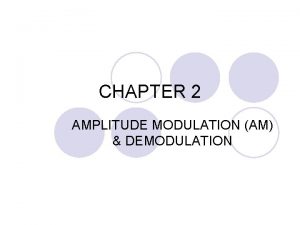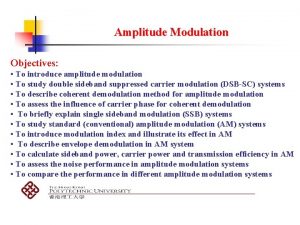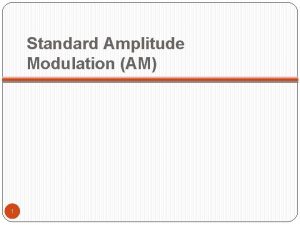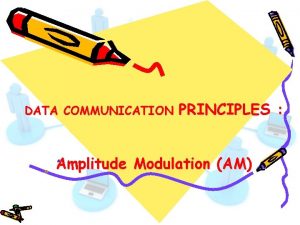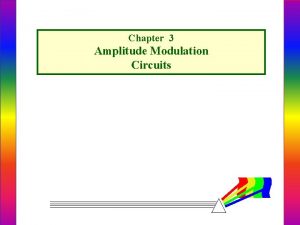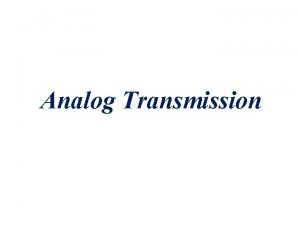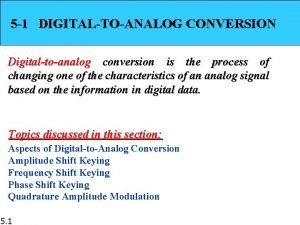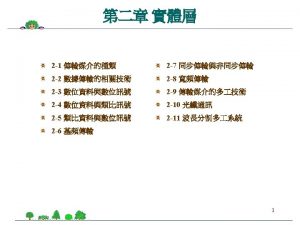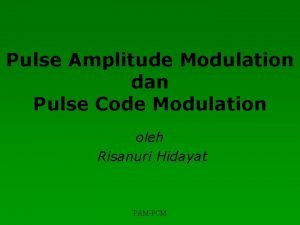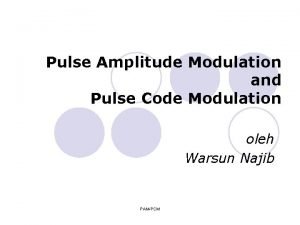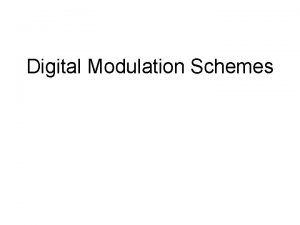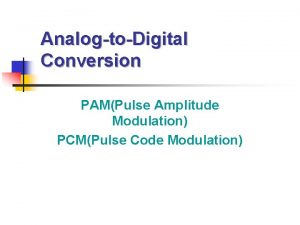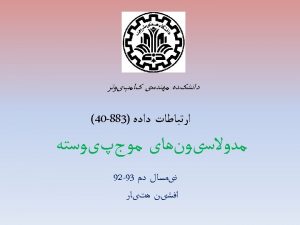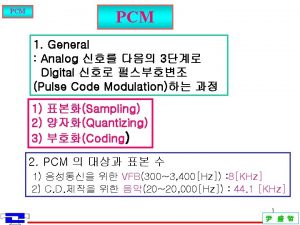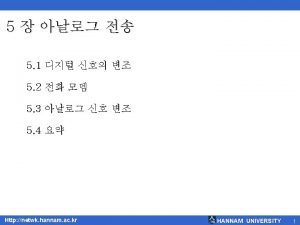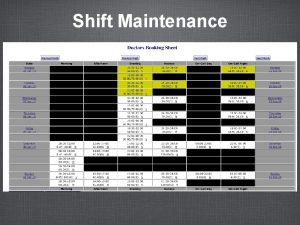Digitaltoanalog modulation Types of digitaltoanalog modulation Amplitude Shift







































- Slides: 39


Digital-to-analog modulation Types of digital-to-analog modulation

Amplitude Shift Keying (ASK) On/Off keying • • The amplitude of the carrier signal is varied to represent binary 1 & 0. Frequency and phase remains the same. Highly susceptible to noise interference. Used up to 1200 bps on voice grade lines, and on optical fiber.

Frequency Shift Keying • Frequency of the carrier is varied to represent digital data (binary 0/1) • Peak amplitude and phase remain constant. • Avoid noise interference by looking at frequencies (change of a signal) and ignoring amplitudes. • Limitations of FSK is the physical capabilities of the carrier. • f 1 and f 2 equally offset by equal opposite amounts to the carrier freq. • In MFSK more than 2 freq are used, each signal element represents more than one bit

Phase Shift Keying • • Phase of the carrier is varied to represent digital data (binary 0 or 1) Amplitude and frequency remains constant. If phase 0 deg to represent 0, 180 deg to represent 1. (2 -PSK) PSK is not susceptible to noise degradation that affects ASK or bandwidth limitations of FSK

BPSK TRANSMITTER BPSK RECEIVER



Signal space diagram of BPSK






4 -PSK (QPSK) method



4 -PSK (QPSK)

4 -PSK (QPSK) COS SIN 45 +0. 707 135 -0. 707 +0. 707 225 -0. 707 315 +0. 707 -0. 707

4 -PSK (QPSK) SIGNAL SPACE DIAGRAM

4 -PSK (QPSK)

QPSK TRANSMITTER a 1 (or) a 2=+√(E/2) (or)-√(E/2)

QPSK RECEIVER

DERIVATION-PROBABILITY OF ERROR IN QPSK

DERIVATION-PROBABILITY OF ERROR IN QPSK

DERIVATION-PROBABILITY OF ERROR IN QPSK

DERIVATION-PROBABILITY OF ERROR IN QPSK

Offset QPSK waveforms • Presence of 180 degree phase shift in QPSK makes the signal to loose constant envelope property. Non linear amplification of such signal causes unwanted side lobes and spectral widening. • In OQPSK maximum phase shift is limited to 90 degree. • Even and Odd bit streams are offset in their relative alignment by one bit period.

Offset QPSK waveforms

Offset QPSK Transmitter

Pi/4 QPSK signaling ØMaximum phase angle change is limited to +135 (or) -135 ØCan be noncoherently detected


Pi/4 QPSK phase shifts

Possible values of Øk are +45, -45, +135, -135

Pi/4 QPSK transmitter

Differential detection of pi/4 QPSK



 Amplitude modulation vs frequency modulation
Amplitude modulation vs frequency modulation Wave modulation
Wave modulation Advantages of angle modulation
Advantages of angle modulation Dscfc
Dscfc Principle of amplitude modulation
Principle of amplitude modulation Am modulation
Am modulation Am vs fm
Am vs fm Frequency modulation and demodulation theory
Frequency modulation and demodulation theory Advantages and disadvantages of pulse code modulation
Advantages and disadvantages of pulse code modulation Amplitude modulation
Amplitude modulation Amplitude period phase shift
Amplitude period phase shift Amplitude phase shift period
Amplitude phase shift period Frequency shift keying modulation
Frequency shift keying modulation Homocyclic diene component
Homocyclic diene component Bathochromic shift and hypsochromic shift
Bathochromic shift and hypsochromic shift Cap 221
Cap 221 Bathochromic shift and hypsochromic shift
Bathochromic shift and hypsochromic shift Difference between arithmetic shift and logical shift
Difference between arithmetic shift and logical shift Logical shift and arithmetic shift
Logical shift and arithmetic shift Gabriel hugh elkaim
Gabriel hugh elkaim Difference between arithmetic shift and logical shift
Difference between arithmetic shift and logical shift Horizontal plane border movement
Horizontal plane border movement Wct+
Wct+ Shift register types
Shift register types Similarities of mechanical and electromagnetic waves
Similarities of mechanical and electromagnetic waves Amplitude wavelength and frequency
Amplitude wavelength and frequency Sine function transformations
Sine function transformations Climas quente
Climas quente Small amplitude oscillatory shear
Small amplitude oscillatory shear Rarefaction on a wave
Rarefaction on a wave Gmr head amplitude
Gmr head amplitude Ecological amplitude definition
Ecological amplitude definition Phase invariance
Phase invariance Difference between pulse doppler radar and mti radar
Difference between pulse doppler radar and mti radar Amplitude mode ultrasound
Amplitude mode ultrasound Dynamics
Dynamics Amplitudes articulaires poignet
Amplitudes articulaires poignet Laisvieji svyravimai
Laisvieji svyravimai Interference by division of amplitude
Interference by division of amplitude Ecg tachycardia no p waves
Ecg tachycardia no p waves
